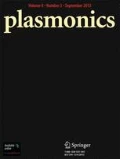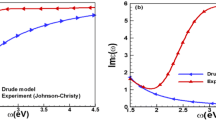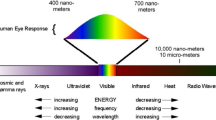Abstract
The color of small gold rods changes dramatically when electrons are injected by chemical reductants. The longitudinal and transverse plasmon modes are both found to blue-shift, and the shift is larger for rods with larger aspect ratios. The color changes are visible to the eye for rods with aspect ratios around 2–3. It is found that the surface plasmon band is damped when charging becomes high. The effects are in qualitative agreement with a model in which the gold plasma frequency increases due to an increase in electron density.






Similar content being viewed by others
References
Mulvaney P (1996) Surface plasmon spectroscopy of nanosized metal particles. Langmuir 12:788
Henglein A, Mulvaney P, Linnert T (1991) Chemistry of Agn Aggregates in Aqueous-Solution—Nonmetallic Oligomeric Clusters and Metallic Particles. Faraday Discuss 92:31
Henglein A, Meisel D (1998) Radiolytic Control of the Size of Colloidal Gold Nanoparticles. Langmuir 14:7392
Ung T, Giersig M, Dunstan D, Mulvaney P (1997) Spectroelectrochemistry of Colloidal Silver. Langmuir 13:1773
Chapman R, Mulvaney P (2001) Electro-optical shifts in silver nanoparticle films. Chem Phys Lett 349:358
Toyota A, Nakashima N, Sagara T (2004) UV-visible transmission-absorption spectral study of Au nanoparticles on a modified ITO electrode at constant potentials and under potential modulation. J Electroanal Chem 565:335
Schmidt GM, Curley-Fiorino ME (1975) In: Bard AJ (ed) Encyclopaedia of Electrochemistry of the Elements. Dekker, New York
Nikoobakht B, El-Sayed MA (2003) Preparation and growth mechanism of gold nanorods (NRs) using seed-mediated growth method. Chem Mater 15:1957
Pérez-Juste J, Liz-Marzán LM, Carnie S, Chan DYC, Mulvaney P (2004) Electric Field Directed Growth of Gold Nanorods in Aqueous Surfactant Solutions. Adv Funct Mater 14:571
Wang ZL, Mohamed MB, Link S, El-Sayed MA (1999) Surface reconstruction of the unstable {110} surface in gold nanorods. Surf Sci 440:L809
Sönnichsen C, Franzl T, Wilk T, von Plessen G, Feldmann J, Wilson O, Mulvaney P (2002) Drastic reduction of plasmon damping in gold nanorods. Phys Rev Lett 88:77402
Palik E (1985) Handbook of Optical Constants of Solids Academic Press, Orlando, FL
Acknowledgments
P.M. wishes to thank the Humboldt Foundation for financial support and Stiftung Caesar. This work was supported through ARC Grant DP 0451651. LMLM acknowledges financial support from the Spanish Ministerio de Educación y Ciencia and FEDER (project # MAT2004-02991).
Author information
Authors and Affiliations
Corresponding author
Appendix
Appendix
Calculation of the Spectra in Figure 6
To calculate the spectrum of polydisperse, charged gold nanorods within the dipole approximation, we first decompose the complex dielectric function [12] into an interband component, which is independent of size, shape, and charge, and a free electron or Drude component,
We then subtract the free electron contribution and add a modified Drude function in which the plasma frequency is modified by an amount \(\omega ^{{\text{2}}}_{{\text{p}}} = {\left( {1 + \Delta N} \right)}{Ne^{2} } \mathord{\left/ {\vphantom {{Ne^{2} } {m\varepsilon _{0} }}} \right. \kern-\nulldelimiterspace} {m\varepsilon _{0} }\)and recalculate the new dielectric function. This enables us to calculate the entire spectrum of the charged gold rods, not just the region around the plasmon modes.
The Drude term becomes:
The uncharged metal has ΔN = 0. In an aqueous environment, the metal particles may be cathodically or anodically charged causing electron density changes of up to 10–15%. This modified dielectric function is used in the standard equations for absorption of light by ellipsoids within the dipole approximation and numerically integrated over the size distribution.
Rights and permissions
About this article
Cite this article
Mulvaney, P., Pérez-Juste, J., Giersig, M. et al. Drastic Surface Plasmon Mode Shifts in Gold Nanorods Due to Electron Charging. Plasmonics 1, 61–66 (2006). https://doi.org/10.1007/s11468-005-9005-0
Received:
Accepted:
Published:
Issue Date:
DOI: https://doi.org/10.1007/s11468-005-9005-0




